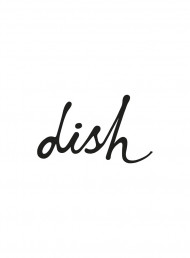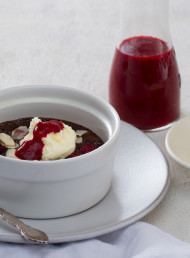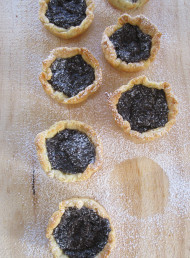Meet: Luke Owen Smith, The Chocolate Bar

What makes a great bar of chocolate? The answer depends entirely on who you're asking. For The Chocolate Bar founder Luke Owen Smith, the artistry of chocolate is all in the craftsmanship. Here, Dish get acquainted with the self-proclaimed chocaholic to discuss why everyone should try a Chocolate Tasting at least once, and where in the world you can get your hands on the best block.
Dish: How did The Chocolate Bar come about?
"It all happened very quickly, back in October 2015. I was managing a craft beer bar in Wellington and for a while I’d had a desire for a change, plus I wanted to work hours that were more in tune with my partner’s. At the same time I had been developing a passion for craft chocolate and feeling frustrated at the extremely limited range that was available in New Zealand. I was ordering from stores in the U.S and Europe, then waiting weeks for deliveries and praying that they wouldn’t melt on the way. One day I had the light bulb moment and realised I should start my own craft chocolate shop.
Initially, I wanted to open a physical store but thankfully I got some sound business advice and realised it would be hard to make money that way, not to mention the fact that it would involve getting a big loan from the bank. So I scaled down the idea and decided to open an online store, as well as attending weekly markets and running all sorts of tasting sessions. As soon as I had the plan clear in my head I just ran with it – the business was up and running about a month after the initial idea."
Have you always had a sweet tooth?
"I have definitely always had a sweet tooth, although I would say I have a lot less of a sweet tooth now than I used to. My grandma used to feed us copious amounts of biscuits and sweets, much to the chagrin of my mum, who was a child of the sixties and very keen on healthy wholefoods. I think I loved that element of rebellion that came with eating sweets – it was always something naughty, and a little secret between my grandma and me."
These days I’m much more health conscious, though I still believe in regular indulgence. But I’m much more interested in the depth of flavour and richness of high quality craft chocolate, as opposed to the sugar content. I used to smash huge blocks of industrial chocolate from the supermarket, whereas now I’ll have a couple of pieces of the good stuff and I’m content for the night. Quality, not quantity."
There’s an art of discovery in what you do. How important is it that your subscribers try something new?
"We certainly want people to have an eye-opening and memorable experience when they try craft chocolate for the first time. We’ve all grown up eating mass-produced chocolate made with the same one or two varietals of cacao, and with a taste that you would always identify as ‘chocolatey’,
What we’re introducing our customers to is the idea that chocolate isn’t just one taste; it has hundreds of flavour notes that can all be found in cacao. It’s like we’ve all spent our lives only tasting lager, and now suddenly there’s this new world of IPAs, stouts, saisons, bitters, etc.
That realisation of the different flavours that can be found in cacao is what really drew me to craft chocolate, and introducing people to this is still the most satisfying part of running The Chocolate Bar. I want people to be able to have a huge variety of delicious experiences, rather than the same experience over and over again."
Do you have a favourite flavour combination?
"In terms of chocolate, my favourite bars are usually the plain single origin bars, which can contain a world of different flavours just from the beans that are used. I don’t have one particular flavour that I like the most, but what I love is when I taste a bar that is nothing like anything I’ve tasted before. Recently I tried a single origin bar from Chocolate Naïve that had such a strong taste of banana and buckwheat – all just from two ingredients of cacao and sugar.
In terms of bars with added flavours, what I really love is when chocolate makers use added ingredients that work in harmony with the natural flavour notes of the cacao. The Hogarth Craft Chocolate Rose & Vanilla Tea bar is a fantastic example of this. It uses a Madagascan cacao that has a really strong raspberry note to it, and that combines with the added rose flavour beautifully."
Most unlikely flavour combination?
"I’ve tried some very weird chocolate bars over the past few years. Some of them have been extraordinarily brilliant, while others have left me feeling a bit ill. I won’t mention the makers but amongst the most offensive were the broccoli white chocolate and the Thai shrimp curry bar. A couple of the best have been the Chocolate Naïve Porcini milk chocolate and the Map Chocolate Meteor Shower, which is a dark-milk chocolate with toasted black sesame and lava salt sprinkled on the back."
What was the process behind the Tasting Course?
"A couple of things inspired the creation of the Chocolate Tasting Course. I’ve found that my tasting events have been very popular and really enjoyable for me to run, so I wanted to help people to have part of that experience at home, and to be able to share it with a variety of people at different times. Secondly, I wanted to create something that would give people the opportunity to taste lots of different bars without having to spend a fortune. And lastly, it’s about spreading the educational element further afield and introducing a wider audience to the incredible world of craft chocolate.
In terms of producing it, it’s really been a culmination of everything I’ve learnt over the past few years, and all of the experiences I’ve had running tasting sessions around the country. I highlighted six different areas that I wanted to share with people, and then set about communicating them in a way that’s hopefully equal parts fun and geeky. As well as learning how to taste chocolate, subscribers will learn about cacao, how chocolate is made, how to pair chocolate with other food and drink, and various other useful and delicious bits of information."
What does a chocoholic gain from signing up to the Tasting Course for six months, as opposed to simply buying their favourite flavours over the counter?
"The Tasting Course will offer a completely different experience to buying chocolate in a shop. It’s an opportunity to taste a wide range of rare and expensive chocolate from around the world, as well as learning how to truly appreciate each piece of chocolate you taste. All of the things that people can learn over the six months will enable them to make much more informed decisions when purchasing chocolate in the future. So it’s not an alternative to buying chocolate over the counter, it’s something that can enhance that process."
Most of us have experienced a wine tasting – what makes a chocolate tasting somewhat more unique?
"I wouldn’t say that a chocolate tasting is more or less unique than a wine tasting. Any type of food or drink tasting can be unique or not, it just depends on the quality of what you’re tasting and the diversity of the selection. What is unique is that we’re taking chocolate to the same level of complexity as wine tasting, which is something that’s quite new to a lot people. Chocolate took a little longer to get to that level because the industry was shrouded in heavy secrecy for the past couple of centuries, both in terms of the cacao trade and production methods. Craft chocolate is blowing the whole thing wide open and everyone’s invited to the party."
When did you first discover craft chocolate?
"My first taste of craft chocolate was the Wellington Chocolate Factory’s Peru Norandino bar. I heard about the factory just before it opened and I was down there on the first or second day. I still remember tasting that Peru bar, with it’s tangy apricot and sweet honey notes, and a flavour that seemed to keep developing in my mouth. It was so different to anything else I’d ever tasted and I’ve been hooked on craft chocolate ever since."
When did you know chocolate was destined to become your life’s work?
"I think I had the gut instinct as soon as I had the idea to start the business. It was a time in my life when everything fell into place and I had that deep down feeling that I had found what I was meant to be doing. That feeling has gone from strength to strength over the past few years, as I’ve built a community of customers, suppliers and collaborators. I think whatever you choose to specialise in, the subject matter is the canvas onto which you can paint a lifestyle."
What does the sustainability factor in chocolate production mean to you?
"There are many causes for concern when it comes to chocolate sustainability – it probably needs a book-length answer but I’ll try to give you a few sentences. As with a lot of agriculture and food production right now, there is a big problem with mass-monocropping and the narrowing of genetic diversity. Most of the cacao that goes into industrial chocolate is one varietal – Forastero. It’s the easiest to grow because it’s strong, disease resistant and produces a high yield.
Unfortunately, it is also the least interesting and usually the least delicious, but the vast majority of the cacao market does not reward good flavour, just high volume. So if you’re a poor farmer, often you’ve got no choice but to grow Forastero (or a couple of other varietals with similar traits.) This has meant that many cacao varietals have become extinct over the years, though with the birth of the craft chocolate movement there is hope in sight that we can start to save rare and heirloom cacao, and reward the farmers who grow it.
It would take too long to properly explain the impact of diversity on sustainability, but let’s just say that with global warming coming into full effect, we need to give ourselves as many options as possible to be able to keep growing cacao as the world goes through drastic change. Diversifying crops gives us many more options in an uncertain future. I should also say that I haven’t touched on the issues of deforestation or sustainability in terms of human livelihood, but I don’t want to turn this interview into a dissertation."
Where could a true chocolate-lover find the world’s best chocolate (in your opinion)?
"Am I allowed to say The Chocolate Bar’s website? Seriously though, if you’re speaking broadly, North America is where it’s at right now. The craft chocolate movement started in the USA in the mid-nineties and they are without a doubt producing a large amount of the highest quality chocolate in the world, although there are incredible craft makers right around the globe. A lot of people look at me like I’m a fool when I say that the best chocolate comes from America – there’s still this common belief that the best chocolate is made in Belgium and Switzerland. That might have been true thirty years ago, but things have changed a lot."
If you had to live off just one bar, for the rest of your life, what would it be and why?
"Oh wow that is a really tough question! You’re speaking to someone whose personal chocolate stash currently fills about four tote bags.
I think the only way I can make that choice is by thinking about which bar I’ve eaten most over the past few years, and that would probably be the Sirene Chocolate Fleur de Sel. It’s a Brazilian single origin bar with tiny flecks of added sea salt, and one of the few bars in our range that I would eat all in one go. A great chocolate bar should be like a great painting – something that you can keep coming back to and finding new subtleties. The Sirene Fleur de Sel definitely ticks that box."
To learn more about The Chocolate Bar or to subscribe to their chocolate delivery service, simply visit their website right here.
latest issue:
Issue #120
As the days become shorter, and the nights cooler, the latest issue is perfectly timed to deliver delicious autumn dishes. From recipes using fresh seasonal produce such as feijoas and apples, to spectacular soothing soups and super-quick after-work meals in our Food Fast section, we’ve got you covered. With Easter on the horizon, we feature recipes that will see you through breakfast, lunch and dinner over a leisurely weekend holiday, and whip up chocolatey baking treats sure to please. We round up delicious dinners for two and showcase a hot new Korean cookbook before heading south to Dunedin to check out all that’s new in food and dining.The latest issue of dish is on sale NOW at all good bookstores and supermarkets – don’t miss it!

 BROUGHT TO YOU BY The Chocolate Bar
BROUGHT TO YOU BY The Chocolate Bar




